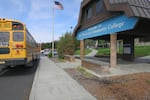
A file photo shows middle schoolers visiting Blue Mountain Community College in June 2020.
Rob Manning / OPB
Following years of enrollment struggles, painful cuts and labor strife, Blue Mountain Community College is growing again.
Earlier this month, the college, based in Pendleton, Oregon, announced fall term enrollment had grown from 1,304 in 2022 to 1,551 this year, a 19% increase. The equivalent number of full-time students — the statistic Oregon uses to determine state funding — also grew significantly and now stands at 407.
BMCC’s growth marks a stark contrast from previous years. From 2012 to 2021, the college’s full-time equivalents shrank from 900 to a little more than 370. This and other drops in state funding eventually led to several successive years of cuts to the college’s instructors, administrators and classified staff, moves that the school’s faculty union vocally opposed.
Even as BMCC’s enrollment stabilized and saw modest growth over the past two school years, the college still laid off 17 employees last spring as it shuttered its GED and adult education programs in state prisons.
College officials struck a more optimistic tone now that the student body is growing again. Sascha McKeon, a biology instructor and the president of the faculty union, said the Pendleton campus feels livelier, not only because the college is attracting more students, but also because BMCC is offering more in-person programming and activities.
“We’ve got more face-to-face classes than we’ve had in the last three years and over 100 additional students, she said. “This is great. The campus feels alive again and so there’s just a lot of energy that is infectious.”
The good vibes carried over to college President Mark Browning, who described himself as “absolutely thrilled.”
BMCC is just one of many community colleges across the country that rebounded after a few years of depressed enrollment. Community college enrollment grew by 4.4% nationally during the fall term, according to the National Student Clearinghouse. While the Oregon Higher Education Coordinating Commission hasn’t yet released statewide community college enrollment, other colleges are starting to report their own numbers independently. According to the Clackamas Print, Clackamas Community College reported an 8.5% enrollment increase during its fall term.
Even with state and national trends working in BMCC’s favor, Browning said college staff still deserve credit for the turnaround in enrollment. He said the college worked hard to cultivate relationships with high schools and community groups to reacquaint them with what the college had to offer.
“The pandemic was so hard on everyone and BMCC was no exception,” Browning said. “I think for some folks, they kind of forgot about us. "
Browning said the college’s smaller growth in previous years allowed it to begin regrowing its staff this year, adding three faculty positions and hiring administrators to cover communications and institutional research.
A substantial bump in enrollment is a double boon for BMCC: New revenue comes in from both tuition and state funding. McKeon said she’ll be keeping an eye on where that extra money goes.
Higher enrollment means instructors have to add more courses, further extending faculty that are already stretched thin, McKeon said. The college’s first instinct, she said, is to add part-time adjunct instructors who can be more easily removed if enrollment drops off again. But McKeon argued that finding quality adjunct instructors in rural Oregon is more difficult when many qualified candidates won’t commit to a part-time job.
She also compared instructor jobs to icebergs, where only 10% of the work is teaching classes. The rest of the workday is spent grading, mentoring, advising and working with other colleagues behind the scenes. McKeon said all of this below-the-surface work is best filled by full-time staff.
“We want to serve our community and add more faculty, add more classes and bring some balance to our course offerings so that it’s not always the general education core, but that our impassioned instructors can teach some of their custom classes or their passion projects,” she said.
For his part, Browning was nonspecific about how BMCC might take advantage of its enrollment boost.
“We’ll consider everything,” he said. “What’s best for the institution and what’s best for the student will always be the foremost criteria that we go to, balanced with the available resources that we have.”
The college will reveal its financial priorities in the spring when it releases its draft budget. The faculty union expects to have more sympathetic voices over the next round of budget hearings. When no one filed for two open seats on the BMCC Board of Education, a couple of former union members won write-in elections and now serve on the board.